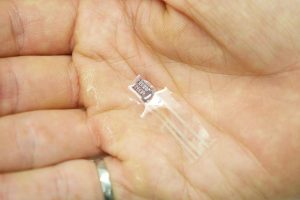When skin comes in contact with an object, electrical signals are sent to brain cells delivering sensory information.
Now, Stanford engineers have created a plastic “skin” that can detect pressure information and generate an electric signal to deliver this sensory input directly to a living brain cell.
Over the past 10 years, Zhenan Bao, a professor of chemical engineering at Stanford, has been trying to develop a material that mimics skin’s ability to flex and heal, while also serving as the sensor net that sends touch, temperature, and pain signals to the brain.

In an attempt to create a flexible electronic fabric embedded with sensors that could cover a prosthetic limb and replicate some of skin’s sensory functions, Bao was able to replicate the sensory mechanism that allows someone to differentiate between different varieties of pressure (a firm handshake vs. a limp handshake).
“This is the first time a flexible, skin-like material has been able to detect pressure and also transmit a signal to a component of the nervous system,” said Bao.
How it works
The breakthrough is centered around a two-ply plastic construct: the top layer creates a sensing mechanism and the bottom layer acts as the circuit to transport electrical signals and translate them into biochemical stimuli compatible with nerve cells.
The top layer also incorporates a sensor that can detect pressure over the same range as human skin, from a light finger tap to a firm handshake.
Bao and her team built upon previous research from five years ago which displayed how to use plastics and rubbers as pressure sensors by measuring the natural springiness of their molecular structures. They then increased this natural pressure sensitivity by indenting a waffle pattern into the thin plastic, which further compresses the plastic’s molecular springs.

To turn these pressure-sensing capabilities electronic, the team scattered billions of carbon nanotubes through the waffled plastic since putting pressure on the plastic squeezes the nanotubes closer together and conducts electricity.
This method let the plastic sensor to mimic human skin and transmit pressure information as short pulses of electricity to the brain. Increasing pressure on the waffled nanotubes squeezes them even closer together, allowing more electricity to flow through the sensor, and those varied impulses are sent as short pulses to the sensing mechanism. Remove pressure, and the flow of pulses relaxes, indicating light touch. Remove all pressure and the pulses cease entirely.
The team then hooked this pressure-sensing mechanism to the second ply of their artificial skin, a flexible electronic circuit that could carry pulses of electricity to nerve cells.
The team needed to prove that the electronic signal could be recognized by a biological neuron by employing a field that combines genetics and optics, called optogenetics in which they bioengineer cells to make them sensitive to specific frequencies of light, then use light pulses to switch cells, or the processes being carried on inside them, on and off.
They translated the electronic pressure signals from the artificial skin into light pulses and activated the neurons, proving that it was possible.
Next Steps
The team aims to create different sensors to replicate different biological processes, like the ability to distinguish corduroy versus silk, or a cold glass of water from a hot cup of coffee. There are six types of biological sensing mechanisms in the human hand, and the Stanford breakthrough is just one of them, but opens the door to adding sensations and developing new mechanisms.
“We have a lot of work to take this from experimental to practical applications,” Bao said. “But after spending many years in this work, I now see a clear path where we can take our artificial skin.”
Story via Stanford University.

